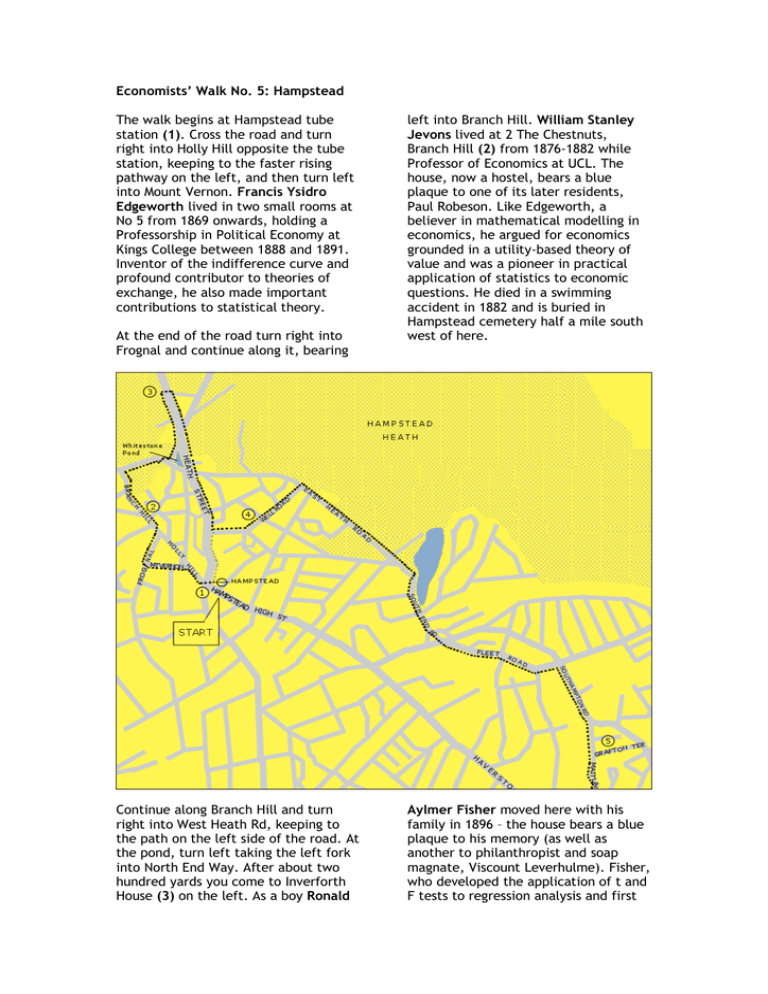Economists’ Walk No. 5: Hampstead Jevons The walk begins at Hampstead tube
advertisement

Economists’ Walk No. 5: Hampstead The walk begins at Hampstead tube station (1). Cross the road and turn right into Holly Hill opposite the tube station, keeping to the faster rising pathway on the left, and then turn left into Mount Vernon. Francis Ysidro Edgeworth lived in two small rooms at No 5 from 1869 onwards, holding a Professorship in Political Economy at Kings College between 1888 and 1891. Inventor of the indifference curve and profound contributor to theories of exchange, he also made important contributions to statistical theory. At the end of the road turn right into Frognal and continue along it, bearing Continue along Branch Hill and turn right into West Heath Rd, keeping to the path on the left side of the road. At the pond, turn left taking the left fork into North End Way. After about two hundred yards you come to Inverforth House (3) on the left. As a boy Ronald left into Branch Hill. William Stanley Jevons lived at 2 The Chestnuts, Branch Hill (2) from 1876-1882 while Professor of Economics at UCL. The house, now a hostel, bears a blue plaque to one of its later residents, Paul Robeson. Like Edgeworth, a believer in mathematical modelling in economics, he argued for economics grounded in a utility-based theory of value and was a pioneer in practical application of statistics to economic questions. He died in a swimming accident in 1882 and is buried in Hampstead cemetery half a mile south west of here. Aylmer Fisher moved here with his family in 1896 – the house bears a blue plaque to his memory (as well as another to philanthropist and soap magnate, Viscount Leverhulme). Fisher, who developed the application of t and F tests to regression analysis and first Retrace your steps to Whitestone Pond and continue ahead down Heath St. Turn left and left again into Well Rd. A blue plaque can be found on the house at 7 Well Road (4) occupied by Karl Pearson and his young son, Egon Pearson. Karl Pearson, professor of eugenics at UCL and discoverer of the chi-squared test and the method of moments, was born a couple of miles east of here in the district of Holloway. Egon Pearson, also at UCL, developed the theory of hypothesis testing with colleague Jerzy Neyman. At this point you have a choice. Returning to Heath St you can turn right and finish the walk at your starting point. Alternatively, if you want proposed maximum likelihood estimation, was born a few miles north of here in Finchley. another 30-40 minutes walk continue to the end of Well Rd, turn right into East Heath Rd and continue into South End Rd. Cross the square and continue into Fleet Rd, turning right when you reach Southampton Rd. Karl Marx, economist and social theorist, lived at 9 Grafton Terrace (5), which you pass on the left, from 1856 to 1864. Proceeding on along Maitland Park Villas you come to Maitland Park Road where Marx and family lived from 1875 onwards and where he died in 1883. (The road is since clearly redeveloped). Marx is buried in Highgate cemetery a mile or so north of here. When you reach Haverstock Hill, turn left and continue for 10 minutes along Haverstock Hill and then Chalk Farm Rd until you reach Camden Lock. Turn left into Jamestown Rd and left again at the end left into Oval Rd (6) where William Stanley Jevons lived as a student in the mid nineteenth century at No 9. At the end turn left and left again into Parkway. You pass Albert St on the right where Jevons also lived as a student at No 13. The walk concludes at Camden Town tube station two stops north of UCL.


